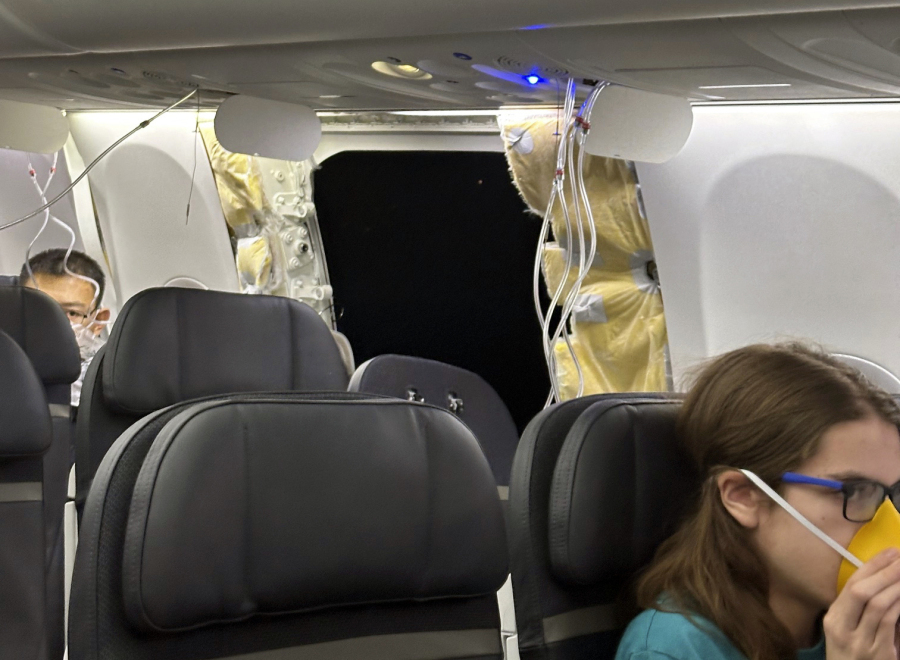Several Alaska Airlines Flight 1282 passengers were hurt when a side of the Boeing 737 MAX 9 burst midflight last week — but injuries could have been much worse had circumstances been slightly different, according to local aviation medicine experts.
The aircraft was about 20 minutes into the flight, headed to Southern California, and had climbed about 16,000 feet when a door plug blew out and left a wide hole in the plane. If the MAX 9 had been at cruising altitude — around 30,000 to 40,000 feet — injuries might have been “catastrophic,” said Dr. William Bensinger, a Seattle aviation medical examiner who’s spent more than 40 years treating and evaluating pilots.
“The most concerning to me would be if someone was sitting in the seat next to the blowout,” Bensinger said. “Rapid decompression like that would cause air to rush out of the cabin, and if someone were sitting in that chair with their seatbelt off, they would get sucked out of the airplane. … It would have happened so fast you couldn’t react.”
On Flight 1282, no one was in the seat directly next to the blowout, but a 15-year-old was sitting in the window seat directly ahead of the hole as the air rushed out of the passenger cabin. His mother, sitting in the middle seat next to him, described to The Seattle Times seeing her son’s seat twisting backward toward the hole, his seat headrest ripped off and sucked into the void and her son’s arms jerked upward.
“It’s basically like a giant vacuum outside the airplane,” said Dr. Keith Lemmon, who retired as a Colonel in the U.S. Army in 2019 and founded Northwest Aviation Medicine in Gig Harbor.
She held on to her son tightly, hooking her arms beneath his arms and wrapped around his back. It wasn’t until after the flight, she said, that she noticed his clothing had been torn off his upper body.
The 10,000- to 20,000-foot difference in altitude means a significant difference in air pressure and available oxygen levels, according to Bensinger. At 16,000 feet, air pressure is “about 90% lower” than what people are used to at sea level, and passengers have about half the level of oxygen they’d normally have, he said. At 30,000 feet, even less oxygen is available in the air — and temperatures are much colder.
Cabins are generally pressurized between 4,000 and 8,000 feet, but if the door had blown out while the plane was at cruise level, people aboard would likely have had less than a minute before losing consciousness, Bensinger said.
On the Alaska flight, a woman put on her own mask before she, with great difficulty, managed to put a mask on to the mom and son. The woman, a stranger to the two, then grabbed onto the mother as she kept a tight grip on her teen.
“It was definitely lucky it happened at a midrange altitude, rather than at a typical cruise altitude,” Lemmon said. “When the oxygen level decreases rapidly like that, you have to get the emergency oxygen masks on quickly or you could become hypoxic.”
Hypoxia, when cells don’t receive enough oxygen from the blood, can cause confusion, difficulty breathing, headaches and anxiety, or generally make people feel “loopy or dizzy,” said Lemmon, who is also a pediatric and adolescent medicine specialist.
“You’re kind of in a surreal state for a while, eventually become unconscious, and if it lasts long enough, can ultimately be fatal,” he added.
Oxygen masks, which automatically drop down in commercial planes when cabin pressure changes, are also key in these situations, replacing any lost oxygen when at higher altitudes, Bensinger said.
Another risk comes from the rapid decompression that happens when there’s a quick change in air pressure outside the body.
“When there’s air trapped in the body, like in the ears or sinuses, and the pressure differential increases significantly, air expands,” Lemmon said.
Because there’s only so much room in fixed body cavities, like in our ears, expanding air pushes out toward the lower pressure outside, causing pain and potentially rupturing eardrums, he said.
“You basically go from high pressure inside the plane to low pressure outside,” he said. “Pressure flows from high to low, so when the air can’t escape, it expands in an attempt to equalize the pressures. And that’s in healthy people.”
Effects can be even greater for those who recently had surgery or who have chronic heart or lung conditions.
“Sometimes surgery can introduce air into your body where you wouldn’t normally have it, like in your chest or abdominal cavities,” Lemmon said. “If you have a surgical wound with sutures, air expanding in the body can put extra pressure on the wound and potentially cause a rupture.”
In this case, the pilot quickly descended to a lower altitude, which equalized the air pressure, allowed for more oxygen and likely increased the air temperature inside the cabin, Lemmon said.
“All things that are problematic are corrected just by returning to a lower altitude,” he added, noting concerns about hypothermia if the plane had remained at a higher altitude for a longer period of time.
While those who were injured in the Friday flight have been medically cleared, psychological and emotional effects from the experience are natural and could linger, Lemmon said.
“When something like that happens to you, anyone would be anxious or scared or terrified,” he said. “You can imagine being that person on the plane. You have no idea what’s going on. You have no idea it’s a mechanical failure, versus an explosion or terrorist attack.”
He encouraged those on the flight to “take good care” of themselves and “seek psychological first aid if you’re having recurrent thoughts about it or trouble sleeping.”



